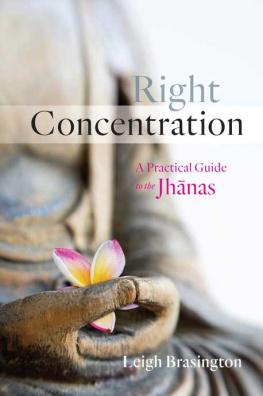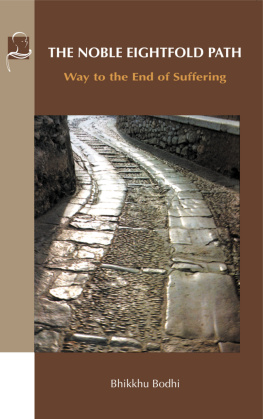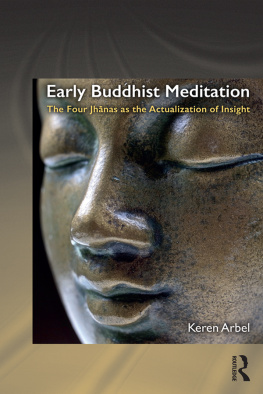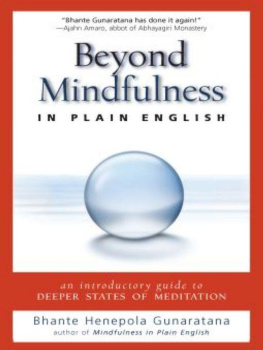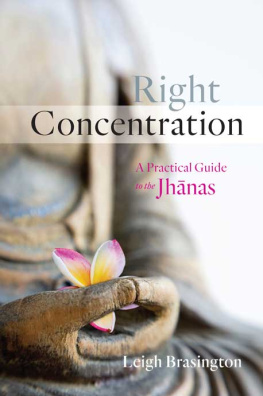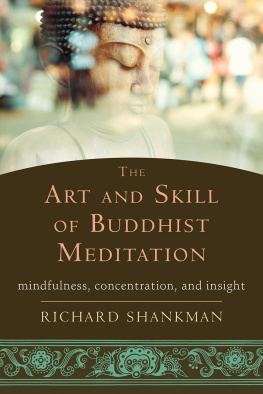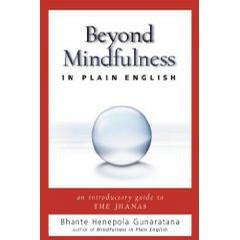For those interested in exploring jhna, Leigh brings many years of skillful teaching to this accessible, clear, and helpful guide.
Jack Kornfield, author of A Path with Heart
Leigh Brasington presents a clear map of jhna practice as he learned it from his teacher, Ayya Khema. As with many aspects of the Buddhas teachings, different traditions and lineages have different views on what constitutes these deeper states of concentration. Leigh offers many examples from his own experience and from his reading of the Buddhist texts in providing a valuable guide to this particular way of understanding and practicing them.
Joseph Goldstein, author of Mindfulness: A Practical Guide to Awakening
ABOUT THE BOOK
The jhnas are eight progressive altered states of consciousness that can be identified with the aspect of the Buddhas Eightfold Path called Right Concentration. Training in concentration leads to these states, each of which yields a deeper and subtler state of awareness than the previous one. The jhnas are not in themselves awakening, but they are a skillful means for stilling the mind in a way that leads in that direction, and they are attainable by anyone who devotes the time and sincerity of practice necessary to realize them. Leigh Brasingtons guide to navigating the jhna path is deeply informed by the view of them transmitted to him by his teacher, Ven. Ayya Khema, a view based on the Pali suttas.
LEIGH BRASINGTON studied the jhnas with the late Ven. Ayya Khema, who authorized him to teach retreats on the jhnas. He was also empowered to teach by Jack Kornfield. He teaches numerous jhna retreats throughout the year, at venues that include Cloud Mountain, Barre Center for Buddhist Studies, Gaia House, Vallecitos, and Southern Dharma. This is his first book.
Sign up to receive news and special offers from Shambhala Publications.

Or visit us online to sign up at shambhala.com/eshambhala.
Right
CONCENTRATION
A Practical Guide to the Jhnas
Leigh Brasington

SHAMBHALA
Boston & London
2015
Shambhala Publications, Inc.
Horticultural Hall
300 Massachusetts Avenue
Boston, Massachusetts 02115
www.shambhala.com
2015 by Leigh Brasington
Cover photos: iStock and Thinkstock
Cover design by Gopa & Ted2, Inc.
All rights reserved. No part of this book may be reproduced in any form or by any means, electronic or mechanical, including photocopying, recording, or by any information storage and retrieval system, without permission in writing from the publisher.
Library of Congress Cataloging-in-Publication Data
Brasington, Leigh, author.
Right concentration: a practical guide to the jhanas / Leigh Brasington.
First edition.
pages cm
Includes bibliographical references and index.
eISBN 978-0-8348-0302-2
ISBN 978-1-61180-269-6 (paperback: alk. paper)
1. MeditationTheravada Buddhism. I. Title.
BQ7280.B73 2015
294.34435dc23
2014049333
For my (so-called) students,
in deep appreciation for all they have taught me
Contents
Publishers Note
This book contains diacritics and special characters. If you encounter difficulty displaying these characters, please set your e-reader device to publisher defaults (if available) or to an alternate font.
AN | Anguttara-Nikya (book.verse) |
Dhp | Dhammapada (verse) |
Dhs | Dhammasaga |
D | Dgha Nikya (PTS page references) |
DN | Dgha Nikya (sutta.verse or sutta.subsection.verse.item) |
Iti | Itivuttaka (verse) |
MN | Majjhima Nikya (sutta.verse) |
PED | Pali-English Dictionary from the Pali Text Society |
SN | Sayutta Nikya (sutta.verse) |
Snp | Sutta-nipta (book.sutta) |
Ud | Udna (book.sutta) |
Vsm | Visuddhimagga (The Path of Purification by |
Buddhaghosa, translated by the Ven. amoli, BPS 1956, 2010) |
NAMO TASSA BHAGAVATO ARAHATO SAMMASAMBUDDHASSA .
Homage to the Blessed One, the Arahat, the Perfectly Awakened Buddha.
T HE JHNAS are eight altered states of consciousness, brought on via concentration, and each yielding a deeper state of concentration than the previous. In teaching the eightfold path, the Buddha defined right concentration to be the jhnas. The jhnas themselves are not awakening, but they are a skillful means for concentrating the mind in a way that leads in that direction, and they are attainable not only by monastics, but also by many serious lay practitioners.
This book is an attempt to transmit what I have learned about the jhnas into a readable form. Since the jhnas dont lend themselves to book learning, this attempt is bound to be less than ideal. Nonetheless, I hope to provide at least some useful information about the jhnas and how they can be used on the spiritual path.
This book assumes some familiarity with both meditation and basic Buddhist teachings.learning the jhnas comes much more easily for those who have attended at least two one-week or longer silent meditation retreats and have a good daily meditation practice of at least forty-five minutes, preferably longer. So Ive written this book for people who have the requisite background for beginning to learn the jhnas. However, if you are primarily interested in learning about the jhnas rather than learning them as a practice, this book should also serve you well.
I have used a number of Pali words, so there is a glossary at the back of this book. It turns out to be easier to be precise by using the words from the suttas than an English word that doesnt really capture the essence of what the Buddha was teaching. The following table should be helpful:
sutta | discourse, teaching |
mett | loving-kindness, unconditional love |
samdhi | indistractability, concentration, pulling/gathering together |
vitakka | thinking |
vicra | examining |
pti | glee, rapture |
sukha | happiness/joy |
dukkha | bummer, unsatisfactoriness, stress, suffering, distress |
That last word, dukkha, is extremely important. The Buddha said on several occasions that he taught dukkha and especially the end of dukkha. This book will hopefully show how jhna practice is very helpful in the quest to gain the deep insights necessary for ending dukkha.
The translations in this book are based on the works of Bhikkhu Bodhi, Maurice Walshe, and Thanissaro Bhikkhu. I have at times altered these translations, occasionally to make something clearer and often to remove the gender specific he/his, for which I have substituted one/onesthe Pali is simply third person singular and literally could be he, she, or one. Since this book is written for a general audience, not a male monastic one, and given the centuries of misogynist patriarchy in Buddhism, I am unwilling to write in a way that gives any credence to that particular misunderstanding of the Buddhas teachings. I have also used
Next page
